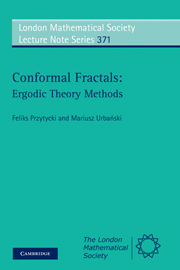Book contents
- Frontmatter
- Contents
- Introduction
- 1 Basic examples and definitions
- 2 Measure-preserving endomorphisms
- 3 Ergodic theory on compact metric spaces
- 4 Distance-expanding maps
- 5 Thermodynamical formalism
- 6 Expanding repellers in manifolds and in the Riemann sphere: preliminaries
- 7 Cantor rep ellers in the line; Sullivan's scaling function; application in Feigenbaum universality
- 8 Fractal dimensions
- 9 Conformal expanding repellers
- 10 Sullivan's classification of conformal expanding repellers
- 11 Holomorphic maps with invariant probability measures of positive Lyapunov exponent
- 12 Conformal measures
- References
- Index
10 - Sullivan's classification of conformal expanding repellers
Published online by Cambridge University Press: 05 April 2013
- Frontmatter
- Contents
- Introduction
- 1 Basic examples and definitions
- 2 Measure-preserving endomorphisms
- 3 Ergodic theory on compact metric spaces
- 4 Distance-expanding maps
- 5 Thermodynamical formalism
- 6 Expanding repellers in manifolds and in the Riemann sphere: preliminaries
- 7 Cantor rep ellers in the line; Sullivan's scaling function; application in Feigenbaum universality
- 8 Fractal dimensions
- 9 Conformal expanding repellers
- 10 Sullivan's classification of conformal expanding repellers
- 11 Holomorphic maps with invariant probability measures of positive Lyapunov exponent
- 12 Conformal measures
- References
- Index
Summary
This chapter relies on ideas of the proof of the rigidity theorem drafted by D. Sullivan in the Proceedings of Berkeley's International Congress of Mathematicians in 1986: see [Sullivan 1986]. In Chapter 7, Example 7.1.10 shows that two expanding repellers can be Lipschitz conjugate, but not analytically (nor even differentially) conjugate.
So in Chapter 7 we provided an additional invariant, the scaling function for an expanding repeller in the line, taking ‘gaps’ into account, and proved that it determined the C1+ε-structure.
In this chapter, following Sullivan, we distinguish a class of conformal expanding repellers (CERs) called non-linear, and prove that the class of equivalence of the geometric measure, and in particular the class of Lipschitz conjugacy, determines the conformal structure.
This is amazing: a holomorphic structure preserved by a map is determined by a measure.
Equivalent notions of linearity
Definition Consider a CER (X, f) for compact X ⊂ ℂ. Denote by Jf the Jacobian of f with respect to the Gibbs measure μX equivalent to a geometric measure mX on X. We call (X, f) linear if one of the following conditions holds:
(a) The Jacobian Jf, is locally constant.
(b) The function HD(X) log∣f′∣ is co-homologous to a locally constant function on X.
(c) The conformal structure on X admits a conformal affine refinement so that f is affine (that is, there exists an atlas {φt} that is a family of conformal injections ϕt: Ut → ℂ where ∪tUt ⊃ X such that all the maps ϕtϕs−1 and ϕtfϕs−1 are affine).
- Type
- Chapter
- Information
- Conformal FractalsErgodic Theory Methods, pp. 284 - 294Publisher: Cambridge University PressPrint publication year: 2010



